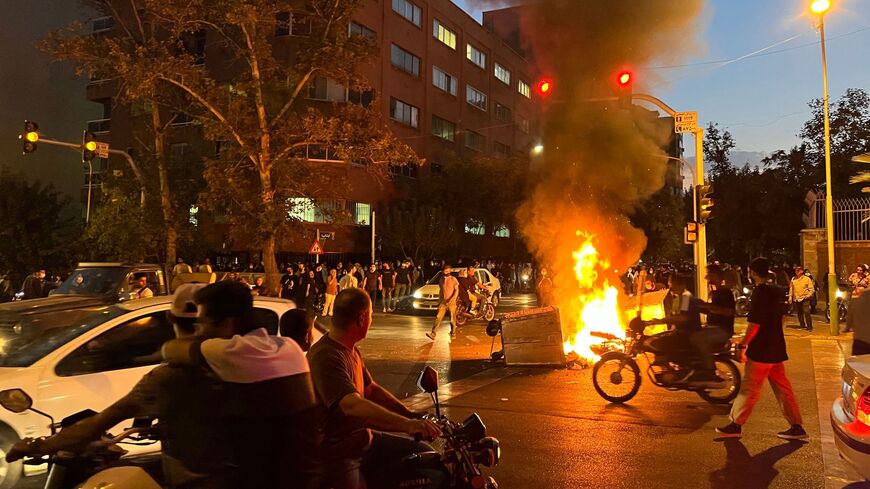Al-Monitor – Activists released footage on Sept. 23 of what appeared to be police directly firing at Iranian protesters, who have been expressing rage at the death of 22-year-old Mahsa Amini while in the custody of the morality police.

In one video, police forces were heard from behind a loudspeaker warning protesters that they would fire only seconds before doing so. Iranian authorities have not commented on those reports, but have earlier denied involvement in the killings, blaming the deaths on “infiltrators, saboteurs and terrorists.”
While an official death toll has yet to be announced, the foreign-based Iran Human Rights organization counted at least 50 deaths by Sept. 23, among them many juveniles.
“We will stand our ground on the streets until the full liberation of our country,” said Salim Haghighi in an interview with Voice of America, less than a day after his 16-year-old son Milan was killed in the north-western city of Oshnavieh.
On the eighth day of the protests, demonstrators chanted slogans against Iran’s Supreme Leader Ayatollah Ali Khamenei, facing off against riot police and plainclothes Basij forces in the conservative cities of Mashhad and Qom, as well as in Karaj, Tabriz, Ardebil, Rasht, Varamin and Sanandaj.
The capital Tehran was particularly tense, with gunfire heard in the affluent Saadatabad district, as security forces scrambled to disperse the crowds. Several other neighborhoods, including Tehransar, Narmak, Sadeghiyeh and Sattarkhan witnessed similar scenes of shooting and huge fires on blocked streets, while a video showed long lines of bike-riding riot police entirely filling the central Vali-Asr square to attack protesters.
The rallies were held despite severe government-imposed internet disruptions, meant to block communication and the transfer of video files. Iranians were thus struggling to connect, especially with such popular services as Instagram and WhatsApp. Many also accused META, the company owning the two platforms, of giving in to the Iranian government’s pressure. The company has denied the allegations.
Harsher clampdown expected
As President Ebrahim Raisi returned from his visit to the UN General Assembly in New York, Iranian authorities appeared to be facing less pressure in their dealing with the protesters.
“If someone has a right word to say, they will be heard, but rioting and jeopardizing public security will not be tolerated,” he said in a live TV speech upon arrival in Tehran.
Separately, the Army of the Islamic Republic, the Intelligence Ministry as well as Friday prayer leaders issued strongly-worded statements on serious action against the protesters.
Iranians also shared online the screenshots of generic messages from their phones, sent by the Intelligence Ministry, warning against attending the rallies.
Apart from hundreds of arrests at protest sites confirmed by the authorities, overnight raids on homes have also been reported, with many political activists rounded up in several provinces.
And in another plan to curb the protests, authorities of at least six universities in Tehran announced that classes will be held only online for the next ten days.
Growing solidarity
Global campaigns to highlight Mahsa’s case and support the protesters continued to gather pace, with a Twitter hashtag under her Persian name reaching close to 48 million references.
More international figures joined the campaign, from German Chancellor Olaf Scholz to prominent British author J. K. Rowling. And gestures of support spread beyond borders. The Kurdish opposition leader Selahattin Demirtas, currently jailed by the Turkish government, shaved his head in support of the protestors.
State-organized rallies
The state-funded broadcaster and hard-line media reported extensively on what they described as “spontaneous” counter-rallies by government loyalists. In one live broadcast, however, a live shot of the crowds suddenly zoomed out, only to accidentally show a nearly empty space around the participants. Another broadcast video also appeared to show banners of a rally held three years ago.
Activists have long argued that the government organizes such rallies with large budgets and media campaigns, while refusing to issue permits for protests planned by opponents. Under the Iranian constitution, peaceful protests, even without permits, are authorized should participants carry no weapons and not act against Islamic rules.
The state media’s coverage of the recent protests has also come under fire for bias. Several video reports have been aired in the past few days alleging that the protesters have been attacking ambulances and buses. The protesters, on the other hand, had already warned about such a narrative, and released videos showing security forces using non-military vehicles as cover.
 Shabtabnews In this dark night, I have lost my way – Arise from a corner, oh you the star of guidance.
Shabtabnews In this dark night, I have lost my way – Arise from a corner, oh you the star of guidance.


